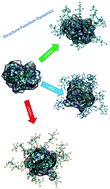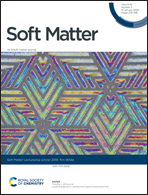Structure–function–dynamics of α-chymotrypsin based conjugates as a function of polymer charge†
Abstract
The field of protein–polymer conjugates has suffered from a lack of predictive tools and design guidelines to synthesize highly active and stable conjugates. In order to develop this type of information, structure–function–dynamics relationships must be understood. These relationships depend strongly on protein–polymer interactions and how these influence protein dynamics and conformations. Probing nanoscale interactions is experimentally difficult, but computational tools, such as molecular dynamics simulations, can easily obtain atomic resolution. Atomistic molecular dynamics simulations were used to study α-chymotrypsin (CT) densely conjugated with either zwitterionic, positively charged, or negatively charged polymers. Charged polymers interacted with the protein surface to varying degrees and in different regions of the polymer, depending on their flexibilities. Specific interactions of the negatively charged polymer with CT caused structural deformations in CT's substrate binding pocket and active site while no deformations were observed for zwitterionic and positively charged polymers. Attachment of polymers displaced water molecules from CT's surface into the polymer phase and polymer hydration correlated with the Hofmeister series.



 Please wait while we load your content...
Please wait while we load your content...